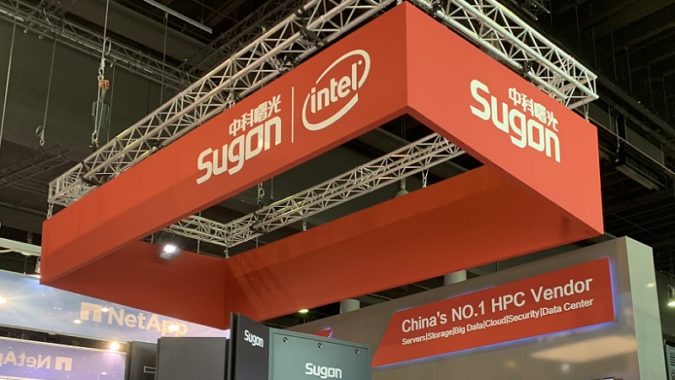After more than a decade of advancing its supercomputing prowess, operating the world’s most powerful supercomputer from June 2013 to June 2018, China is keeping mum on its latest HPC accomplishment.
According to multiple sources (with further confirmation yesterday from the South China Morning Post), Chinese vendor Sugon (known also as Dawning Information Industry Co.) was poised to stand up the new no. 1 supercomputer at the International Supercomputing Conference in Germany last week. But Sugon pulled back the entry despite attaining benchmarking results 2x higher than the U.S.-based Summit supercomputer, currently ranked no. 1 in the world.
With trade and tech war tensions heightened in advance of U.S. President Donald Trump’s and Chinese leader Xi Jinping’s planned meeting at the G20 summit this month, sources told us that China did not wish to invite scrutiny and potentially face the same sanctions as Huawei. Nevertheless, on Friday (June 21) the day after ISC wrapped up, Sugon and four other Chinese organizations were placed on the U.S. “entity list” by the U.S. Commerce Department, which cited risks to American national security or foreign policy interests. The action effectively bars the named entities from accessing advanced U.S. computing technologies.

Despite holding back its benchmarking news, Sugon generated a lot of attention at ISC with the demonstration of Nebula, its “Next Generation Silicon Cube High Performance Computer” that features phase change immersive cooling. Standing roughly 4 meters high by 2.5 meters wide, the two-rack system in Sugon’s booth, when fully equipped, holds 160 dual-node blades for a total of 320 nodes. Each node houses one China-made AMD x86 CPU and four AMD GPUs. The AMD CPU is China’s version of the Epyc processor, licensed through AMD’s joint venture with THATIC (a Chinese holding company also added to the entity list). Sugon told HPCwire the system also supports Intel x86-plus-AMD GPU gear, and booth signage indicated Intel partnership status. The Silicon Cube computer leverages fat tree topology and 6D-Torus high-speed network technology with 200 Gbps interconnection, according to Sugon.
Employing liquid cooling technology in development since 2012, Sugon claims Nebula has a PUE of less than 1.04. An interesting experimental version of Sugon’s LC tech was on display at SC15, and the concept for the supercomputing cube was introduced a year later.

A version of the Silicon Cube computer (that held up to 40 blades per rack) was unveiled internationally at SC18. This year’s release at ISC marks the fourth generation of the liquid-cooled Silicon Cube supercomputer. Although Sugon is working on developing new processing technologies as part of its involvement in China’s pursuit of exascale computing (the company is backing one of China’s three exascale prototypes), the company relies heavily on U.S. chips, such as Intel, AMD and Nvidia, especially in the commercial market, and its business is expected to take a hit from the export restriction.
Sugon promotes itself as the number one HPC server vendor in China. On the latest Top500 list, Sugon’s 63 benchmarked systems gave it a third place ranking by system share, and the company placed fifth in aggregate performance share. Sugon’s Advanced Computing System (PreE) is 43rd in the global rankings; comprised of more than 5,000 Hygon Dhyana CPUs, Epyc clones originating out of the AMD-THATIC partnership, connected with 200 Gbps networking in a 6D-Torus topology.
In a statement to Bloomberg, an AMD spokesperson said, “AMD will comply with the regulations governing that [entity] list, just as we have complied with U.S. laws to date. We are reviewing the specifics of the order to determine next steps related to our joint ventures with THATIC in China.” AMD CEO Lisa Su had earlier confirmed at Computex in May that AMD’s licensing agreement with THATIC was limited to first-generation Zen cores. “The joint venture is a single-generation technology license and there are no additional technology licenses,” Su told Tom’s Hardware at the time.

In 2010, Sugon was the first company to bring China into the global top two for supercomputing with Nebulae, a Dawning blade system, at the National Supercomputing Centre (NSCS), in Shenzhen, comprised of Intel Xeons and Nvidia GPUs. For over a decade, China has relied primarily on U.S. technologies to power its leadership systems until export blocks put in place by the U.S. in 2015 accelerated China’s efforts to develop a homegrown supercomputing program. In June 2016, China stood up the number one system, the Sunway TaihuLight, built entirely with processors designed and manufactured in China.

The three organizations leading China’s development of exascale high performance computing – Sugon, the Wuxi Jiangnan Institute of Computing Technology and the National University of Defense Technology (NUDT) – are all on the U.S. entity list. The latter was added in February 2015 “because of its use of U.S.-origin multicores, boards, and (co)processors to power supercomputers believed to support nuclear explosive simulation and military simulation activities,” stated the U.S. Department of Commerce. In addition, NUDT was found to be accessing restricted U.S. technology while using various aliases (listed under multiple addresses), and the list has been updated to include those aliases and locations.
Friday’s U.S. Commerce Department ruling stated that “Sugon has publicly acknowledged a variety of military end uses and end users of its high-performance computers.” In light of the latest restrictions, China will likely be further incentivized to speed up its “self-controllable” semiconductor technologies. It has several swim lanes in play at the leadership computing level, and RISC-V and VIA are contenders for general-purpose processing and beyond, but there is no readily available IP to replace U.S. chip technology in the near-term, especially in the business sector.
On Monday Sugon announced it had suspended trading of its shares and would resume trading on July 1 at the latest. “We are verifying relevant content and comprehensively evaluating the impact of the ban and making preparations,” the company said in a statement filed with the Shanghai Stock Exchange. “We will be well-prepared and keep active communication with all parties.”





























































